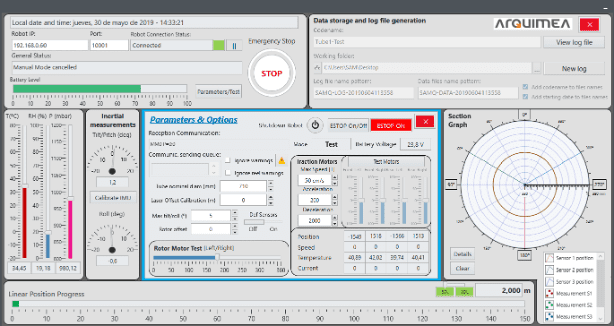- Sectors
- Aerospace & Defense
- Big science
- Biotechnology
- Fintech
- Work at ARQUIMEA
- Insights

ANDRA is the French Agency responsible for granting the safe management and disposal of the radioactive waste to protect the present and future generations from the risks inherent in such substances. ANDRA oversees the Cigèo project (Industrial Centre for Geological Disposal) consisting of a deep geological facility aimed for disposing of the highly radioactive long-lived waste. Within this frame, the Underground Laboratory of Bure was built as an exceptional tool to perform the research activities required to implement Cigèo.
SAM (Systèm d’Auscultation Mobile por l’alvéole AHA) is a high-precision robot that performs different types of measurements inside High Level (HL) disposal cell casings. The HL disposal cells are “micro-tunnels” of at least 80m long and internal diameter of approx. 0.7m in which the waste packages will be placed. SAM is to be used in a set of underground experiments to produce a cell demonstrator and study its behavior.
SAM moves through the pipe and checks the consistency of values from the “outer casing” measuring devices. These activities will be repeated in several campaigns to monitor how the parameters change over time.
SAM can measure with high accuracy its own position in the disposal cell, longitudinally as well as when pitching and rolling; casing geometry by analyzing the out-of-roundness of the inner part of the pipe and the environmental atmospheric conditions. It is also adjustable so it can host additional measurement systems.
SAM exploring a pipeline. Copyright: ANDRA (Agence Nationale pour la gestion des déchet radioactifs)
ANDRA was looking of for an autonomous system with high precision in the measurements and low maintenance needs. The following elements were critical to ensure the success of the project:
SAM has been designed to obtain high precision data from deformation measurements within up to 150m long and from 610 to 710mm diameter tubes in horizontal position (±1o). Some of the aspects to highlight are the following:


Every subcomponent of the system has been tested and validated by ANDRA at the final inspection stage prior delivery.
One test has been performed so far at the underground laboratory of Bure on July 2019. SAM successfully responded within the specifications of the experiment, aiming to determine de baseline of an HL cell. Further campaigns will be performed shortly by ANDRA to monitor the parameters’ evolution at the same cell.
SAM will be used as standard basis for the measurement and monitoring of AHA cells to be built at the Underground Laboratory of Bure from 0 to 150m long but can be easily upgraded to longer distances. SAM demonstrated how a high level of customization can be obtained using standard mobile platforms with short development times. The resulting system is designed targeting a cost affordable future production of several units and with short lead times.